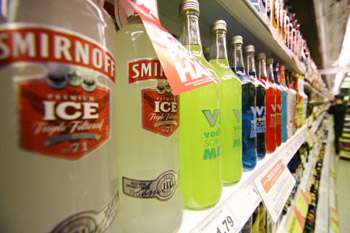Cracking the Code

It’s been five months since the voluntary code came into force but some remain unclear about the dos and don’ts. MOP makes it clear
19 May 2009
Section 9 of the Intoxicating Liquor Act 2008 provides for the exposure for sale and actual sale of intoxicating liquor
(except wine) to be confined to a part of the premises which is structurally separate from the remainder of the premises by means of a wall or similar barrier, which is accessed by a door, gate or turnstile.
A Code of Practice has been drawn up by Retail Ireland, the CSNA and RGDATA in conjunction with the Departments of Justice, Equality and Law Reform, and Health and Children to effectively achieve the object of Section 9,
without the need for the actual sales transaction to take place with the display area. Section 9, although passed into law, has not been commenced and is therefore in a suspended state to give the sector an opportunity to see if the Code of Practice achieves its objectives.
The main principle behind the Code of Practice is that alcohol is not an ordinary household product despite being sold in supermarkets, petrol stations and convenience stores and that it requires to be sold under conditions which recognise this principle.
The Code provides for an independent audit and verification system to oversee compliance and the provision of an annual report to the Minister for Justice, Equality and Law Reform. The credibility of the Code depends on the independent audit and verification system and if the audit process points to the Code achieving the aims of Section 9 of the Intoxicating Liquor Act 2008 as referred to above it may not be necessary to commence this section into law.
Avoiding the implementation of Section 9 is of great benefit to the mixed trading sector as it allows payment for alcohol to continue to be taken at the normal checkouts in the store, which saves the considerable overhead of having to have a separate register in a structurally separate unit simply to take the alcohol sales. The Code covers eight main areas and a good understanding of and commitment to these principles are crucial for all employees involved in the display and sale of alcoholic products in mixed trading premises.
These guidelines should be read in conjunction with the Code of Practice for sale and display of alcohol products and the explanatory guide which may be viewed on the website of Responsible Retailing of Alcohol in Ireland (www.rrai.ie).
1 Displaying the Code
The laminated copy of the Code of Practice must be displayed in a conspicuous space, in clear sight of every customer who visits the store. In larger stores a number of laminated copies may need to be displayed. It must contain the name and address of the licence holder.
The laminated copy represents the commitment of the licence holder to implement the standards of the Code and abide by its provisions. It also alerts customers to the standards which they are entitled to expect.
2 Display of alcohol
Alcohol products must, as far as possible, be displayed only in a part of the premises through which customers do not have to pass in order to obtain access to other beverages and food products (except where, for security reasons, such products are displayed behind the counter.
Alcohol products may not, however, be displayed in the windows of the premises. Separate display need not, of necessity, involve a physical wall or other such physical barrier. Cross-merchandising of alcohol with other food products is forbidden.
Alcohol products must be confined to that one part of the premises and will, as far as possible, be separated from other beverages and food products. It is expected that all mixed trading premises, irrespective of size or level of specialisation, will endeavour as far as possible to implement the separation provisions.
The display provisions are the key area of the Code and therefore, the independent audit and verification system will focus on whether or not the licence holder is complying with them. A failure by the sector to comply with these standards may result in the activation of section 9 of the 2008 Act requiring structural separation and separate till arrangements.
3 Advertising of alcohol
In-store advertising of alcohol products must be confined to the area in which they are displayed and may not be placed in windows or at internal locations where it is intended to be seen from outside the premises.
Advertising materials produced by retailers should not be aimed at minors and should not seek to glamorise alcohol consumption or encourage excessive consumption.
4 Sale of alcohol
The sale of alcohol products is permitted only between 10.30am and 10.00pm on weekdays and Saturdays and between 12.30 pm and 10.00 pm on any Sunday or St Patrick’s Day (sales are not permitted on Christmas Day and Good Friday). Ideally alcohol sales should be blocked at cash registers outside of these times.
Alcohol products must be sold only at clearly designated checkout points by persons over the age of 18 years. Checkout points at which alcohol products are sold, or alternatively the display area, must be monitored by CCTV to assist the enforcement of the statutory provisions.
The sale of alcohol products by unsupervised self-service means is not permitted and “online sales” customers must pay for alcohol at the time of placing the order. The sale of alcohol products on a “pay-on-delivery” basis is an offence under the licensing laws.
It is timely in this context to remind licence holders that they should have a robust control system in place to ensure alcohol is not delivered to underage persons. The inclusion of these provisions regarding the sale and delivery of alcohol are intended to assist licence holders to comply with existing law.
5 Proof of age
It is an offence to sell or deliver alcohol to a person under 18 years of age. Production of a proof-of-age document should be demanded in all cases where the customer appears to be under the age of 21 years or otherwise where there is a doubt about his or her age. The Garda Age Card is the preferred proof-of-age document.
6 Staff training
Store managers and/or licence holders must ensure adequate training of staff members engaged in the display and sale of alcohol products and, in particular, ensure that such staff members have an adequate knowledge and understanding of the relevant areas of licensing law, particularly relating to the sale of alcohol to persons under 18 years and of the voluntary Code of Practice.
7 Independent audit
Compliance with this Code of Practice is subject to independent audit and verification on an annual basis by an independent body selected by the representative bodies of the mixed trading sector. The Code will be updated from time to time. The outcome of the annual audit will be included in the independent Chairman’s report to the Minister of Justice, Equality and Law Reform.
8 Complaints procedure
The Code contains provision for a complaints mechanism which will permit customers to lodge complaints where it appears that the Code’s provisions are not being implemented. Complaints regarding implementation of the voluntary Code should in the first instance be acknowledged, dealt with and resolved at store level by the store manager or the holder of the alcohol licence.
The copy of the Code on display must contain contact details of the licence holder and the body responsible for monitoring the implementation of the Code. If a customer’s complaint regarding compliance with the Code is not dealt with to their satisfaction, they have the right to forward their complaint to: The Chairperson, Responsible Retailing of Alcohol in Ireland (RRAI), c/o 84-86 Lower Baggot Street, Dublin 2.
Code compliance checklist
- Is the Code of Practice clearly displayed in your store?
- Has alcohol been merchandised together in one location in store except where, for security reasons, such products are displayed behind a counter but not in a window?
- Have you made sure that your customers do not have to pass the alcohol section to purchase other beverage and food products?
- Have all alcohol cross merchandising units been removed from around your store?
- Have end of aisle alcohol displays been removed?
- Have you removed all alcohol advertising from the rest of your store apart from the display area?
- Has all external alcohol advertising been removed?
- Has all alcohol and alcohol promotional material been removed from windows?
- Has all alcohol promotional material been removed from store entrances?
- Is there a CCTV camera either on the alcohol till or on the alcohol display area?
- Do all your checkouts have clear signage as to where you can purchase alcohol?
- Have you taken steps to ensure that customers cannot purchase alcohol outside permitted hours?
© Matheson Ormsby Prentice 2009
The information in this article is not intended to provide, and does not constitute, legal or any other advice on any particular matter, and is provided for general information purposes only.
This legal update is compiled by Lorraine Compton, the Head of the Retail and Leisure Group of leading corporate law firm, Matheson Ormsby Prentice. The firm’s Retail and Leisure Group comprises lawyers who provide a one-stop shop designed to cater for every aspect of the retail and leisure business.
For more detailed legal advice please contact Lorraine Compton at Matheson Ormsby Prentice, Solicitors, 70 Sir John Rogerson’s Quay, Dublin 2, by telephone on 01 232 2000 or by email at lorraine.compton@mop.ie.
Further information on the firm is available at www.mop.ie



 Print
Print






Fans 0
Followers